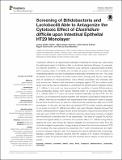Por favor, use este identificador para citar o enlazar a este item:
http://hdl.handle.net/10261/152952COMPARTIR / EXPORTAR:
 SHARE SHARE
 CORE
BASE CORE
BASE
|
|
| Visualizar otros formatos: MARC | Dublin Core | RDF | ORE | MODS | METS | DIDL | DATACITE | |

| Título: | Screening of Bifidobacteria and Lactobacilli Able to Antagonize the Cytotoxic Effect of Clostridium difficile upon Intestinal Epithelial HT29 Monolayer |
Autor: | Valdés, Lorena CSIC; Alonso Guervos, Marta; García Suárez, Olivia; Gueimonde Fernández, Miguel CSIC ORCID ; Ruas-Madiedo, Patricia CSIC ORCID | Fecha de publicación: | 22-abr-2016 | Editor: | Frontiers Media | Citación: | Front. Microbiol. 7: 577 (2016) | Resumen: | Clostridium difficile is an opportunistic pathogen inhabiting the human gut, often being the aetiological agent of infections after a microbiota dysbiosis following, for example, an antibiotic treatment. C. difficile infections (CDI) constitute a growing health problem with increasing rates of morbidity and mortality at groups of risk, such as elderly and hospitalized patients, but also in populations traditionally considered low-risk. This could be related to the occurrence of virulent strains which, among other factors, have high-level of resistance to fluoroquinolones, more efficient sporulation and markedly high toxin production. Several novel intervention strategies against CDI are currently under study, such as the use of probiotics to counteract the growth and/or toxigenic activity of C. difficile. In this work, we have analyzed the capability of twenty Bifidobacterium and Lactobacillus strains, from human intestinal origin, to counteract the toxic effect of C. difficile LMG21717 upon the human intestinal epithelial cell line HT29. For this purpose, we incubated the bacteria together with toxigenic supernatants obtained from C. difficile. After this co-incubation new supernatants were collected in order to quantify the remnant A and B toxins, as well as to determine their residual toxic effect upon HT29 monolayers. To this end, the real time cell analyser (RTCA) model, recently developed in our group to monitor C. difficile toxic effect, was used. Results obtained showed that strains of Bifidobacterium longum and B. breve were able to reduce the toxic effect of the pathogen upon HT29, the RTCA normalized cell-index values being inversely correlated with the amount of remnant toxin in the supernatant. The strain B. longum IPLA20022 showed the highest ability to counteract the cytotoxic effect of C. difficile acting directly against the toxin, also having the highest capability for removing the toxins from the clostridial toxigenic supernatant. Image analysis showed that this strain prevents HT29 cell rounding; this was achieved by preserving the F-actin microstructure and tight-junctions between adjacent cells, thus keeping the typical epithelium-like morphology. Besides, preliminary evidence showed that the viability of B. longum IPLA20022 is needed to exert the protective effect and that secreted factors seems to have anti-toxin activity. | Versión del editor: | http://dx.doi.org/10.3389/fmicb.2016.00577 | URI: | http://hdl.handle.net/10261/152952 | DOI: | 10.3389/fmicb.2016.00577 | ISSN: | 1664-302X |
| Aparece en las colecciones: | (IPLA) Artículos |
Ficheros en este ítem:
| Fichero | Descripción | Tamaño | Formato | |
|---|---|---|---|---|
| Screening of Bifidobacteria and Lactobacilli.pdf | 1,03 MB | Adobe PDF |  Visualizar/Abrir |
CORE Recommender
PubMed Central
Citations
22
checked on 20-abr-2024
SCOPUSTM
Citations
46
checked on 16-abr-2024
WEB OF SCIENCETM
Citations
37
checked on 27-feb-2024
Page view(s)
282
checked on 23-abr-2024
Download(s)
203
checked on 23-abr-2024

